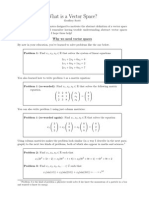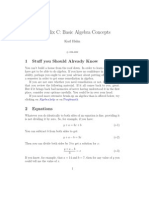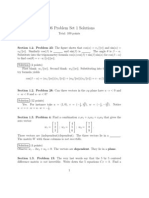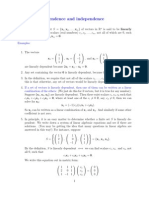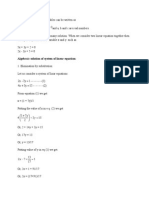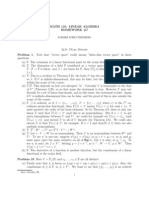Assignment 4 Answers Math 130 Linear Algebra
Assignment 4 Answers Math 130 Linear Algebra
Uploaded by
Cody SageCopyright:
Available Formats
Assignment 4 Answers Math 130 Linear Algebra
Assignment 4 Answers Math 130 Linear Algebra
Uploaded by
Cody SageOriginal Description:
Original Title
Copyright
Available Formats
Share this document
Did you find this document useful?
Is this content inappropriate?
Copyright:
Available Formats
Assignment 4 Answers Math 130 Linear Algebra
Assignment 4 Answers Math 130 Linear Algebra
Uploaded by
Cody SageCopyright:
Available Formats
of homogeneous equations has a solution, namely 0. 2d. Solve the system of linear equations.
Assignment 4 answers Math 130 Linear Algebra
D Joyce, Fall 2012 Exercises from section 1.4, page 32, exercises 1, 2ad, 3ad, 5de, 6, 14. 1. True/false a. The zero vector is a linear combination of any nonempty set of vectors. True. Its 0 = 0v1 + + 0vn . Moreover, an empty sum, that is, the sum of no vectors, is usually dened to be 0, and with that denition 0 is a linear combination of any set of vectors, empty or not. b. The span of the empty set is . False. Its the trivial vector space that includes only the zero vector 0. For convenience, our text made that a special case of the denition. If you dene an empty sum to be 0, then you dont have to make it a special case. c. If S is a subset of a vector space V , then span(S) is the intersection of all subspaces of V containing S. True. See theorem 5. d. In solving a system of linear equations, it is permissible to multiply an equation by any constant. False. Its almost true, but you cant multiply it by 0. That would be the same as erasing the equation. e. In solving a system of linear equations, it is permissible to add any multiple of one equation to another. True. (But you cant add 1 times the equation to itself.) f. Every system of linear equations has a solution. False. There are inconsistent systems like xy = 3 and x y = 4. Note, however, that every system 1
x1 + 2x2 + 2x3 = 2 x1 + 8x3 + 5x4 = 6 x1 + x2 + 5x2 + 5x4 = 3 You can solve this by hand in many ways using row operations. Heres one. Youd probably start by subtracting the rst from each of the second and third rows to get x1 + 2x2 + 2x3 = 2 2x2 + 6x3 + 5x4 = 8 x2 + 3x3 + 5x4 = 1 At this point theres more than one natural way to continue. Since I dont like to work with fractions, Ill switch the second and third rows, then negate the new second row to get x1 + 2x2 + 2x3 = 2 x2 3x3 5x4 = 1 2x2 + 6x3 + 5x4 = 8 Next, Ill add twice the second row to the third row to get x1 + 2x2 + 2x3 = 2 x2 3x3 5x4 = 1 5x4 = 10 And divide the third row by 5. x1 + 2x2 + 2x3 = 2 x2 3x3 5x4 = 1 x4 = 2 The system is now in echelon form. Im going to continue to put it into reduced echelon form. First Ill add 5 times the third row to the second. x1 + 2x2 + 2x3 x2 3x3 + x4 = 2 = 9 = 2
Then subtract twice the second from the rst. x1 + x2 + 8x3 + 3x3 + x4 = 16 = 9 = 2
d. (2, 1, 0), (1, 2, 3), (1, 3, 2) Solve the vector equation x(1, 2, 3) + y(1, 3, 2) = (1, 1, 0) by solving the system of linear equations
Its in reduced echelon form. The third equation x + y = 1 tells me that x4 = 2; the second that x2 = 3x3 + 9; 2x 3y = 1 and the rst that x1 = 8x3 16. None of them 3x + 2y = 0 say what x3 is, and thats because x3 can be any which has the solution (x, y) = ( 2 , 3 ), so the rst 5 5 number. Thus, the general solution is vector is a lin combo of the other two. (x1 , x2 , x3 , x4 ) = (8x3 16, 3x3 + 9, x3 , 2) 5. Determine if the given vector v is in the span where x3 can be any number. Weve found the gen- of a set S. eral solution parameterized by the variable x3 . d. v = (2, 1, 1, 3), You may have done it dierently and found the S = {(1, 0, 1, 1), (0, 1, 1, 1)}. general solution parameterized some other way. This is the same question as exercise 3, but All solutions will describe the same set in R4 . Its worded dierently, so you can answer it in the same a particular straight line that doesnt pass through way, namely, by solving the vector equation the origin. Thats easier to see if you write the x(1, 0, 1, 1) + y(0, 1, 1, 1) = (2, 1, 1, 3). solutions as x = t(8, 3, 1, 0) + (16, 9, 0, 2) where t = x3 is a parameter. 3. Is the rst vector a linear combination of the other two? a. (2, 0, 3), (1, 3, 0), (2, 4, 1) The general method to solve questions like this is to solve a vector equation, in this case, the vector equation x(1, 3, 0) + y(2, 4, 1) = (2, 0, 3). That corresponds to a system of three equations in two unknowns x + 2y = 2 3x + 4y = 0 y = 3 This one is particularly easy to solve. x has to be 2 for the rst coordinate to work out, and y has to be 1 for the second coordinate. And with those values of x and y, the third and fourth coordinates match, too. So there is a solution, and that means v is in the span of S. e. v = x3 + 2x2 + 3x + 3, S = {x3 + x2 + x + 1, x2 + x + 1, x + 1}. Here, the vector space is the set of polynomials of degree 3 or less. There are various shortcuts, but you could use the same method of solving the vector equation s(x3 + x2 + x + 1) + t(x2 + x + 1) + u(x + 1) = x3 + 2x2 + 3x + 3. That corresponds to the system of linear equations (one equation for each power of x) s = 1 s + t = 2 s + t + u = 3 s + t + u = 3
Then use whatever method you want to solve the system. This particular system has a solution, (x, y) = (4, 3). Therefore, the rst vector is a Since theres a solution, namely, (s, t, u) = (1, 1, 1), therefore v is in the span of S. linear combination of the other two. 2
6. Show that the vectors (1, 1, 0), (1, 0, 1), and where v1 , . . . , vk S1 and vk+1 , . . . , vn S2 . Then (0, 1, 1) generate F 3 . w is the sum of the two vectors, c1 v1 + + ck vk Here, F is the scalar eld. We need to show that in the span of S1 , and ck+1 vk+1 + + cn vn in the every vector (a, b, c) in F 3 is a linear combination span of S2 . And, of course, the sum of two such of the three vectors. There are a couple approaches vectors is a vector in the span of S1 S2 . The primary advantage of the more detailed you could take. proof is that it emphasizes that the terms in the One way is to show that the three standard vectors (1, 0, 0), (0, 1, 0), and (0, 0, 1) are linear com- sum need to be rearranged to express the sum w as binations. Since all vectors in F 3 can be generated the sum of two vectors, one from span(S1 ) and the by them, if we can generate them, well be able to other from span(S2 ). generate all vectors. (This depends on the theoMath 130 Home Page at rem: a linear combination of linear combinations http://math.clarku.edu/~djoyce/ma130/ is a linear combination.) So, how can you get (1, 0, 0)? You can nd it by the techniques of the earlier exercises or just look for it. Youll nd (1, 0, 0) = (1, 1, 0) + (1, 0, 1) (0, 1, 1). The other two standard vectors are similarly two of the given vectors minus the third. An alternate way is to show that an arbitrary vector (a, b, c) in F 3 is a linear combination of the three vectors. In other words, solve the vector equation x(1, 1, 0) + y(1, 0, 1) + z(0, 0, 1) = (a, b, c) for x, y, and z in terms of a, b, and c. 14. Show that if S1 and S2 are arbitrary subsets of a vector space V then the span of their union, span(S1 S2 ), equals the sum of their spans, span(S1 ) + span(S2 ). An element of span(S1 S2 ) is a linear combination of vectors in S1 S2 , while an element of span(S1 ) + span(S2 ) is the sum of two vectors, one being a lin combo of vectors in S1 , the other being a lin combo of vectors in S2 . But a lin combo of vectors in S1 S2 is the sum of a lin combo of vectors in S1 and a lin combo of vectors in S2 , and vice versa. We can add details to the argument as follows. Let the vector w be the linear combination of vectors in S1 S2 , and arrange the terms so that the vectors in S1 come before the vectors in S2 . w = c1 v1 + + ck vk + ck+1 vk+1 + + cn vn 3
You might also like
- (Solution Manual) Contemporary Linear Algebra by Howard Anton, Robert C. BusbyDocument259 pages(Solution Manual) Contemporary Linear Algebra by Howard Anton, Robert C. BusbyLijun_Sun_326879% (14)
- (Solution Manual) Contemporary Linear Algebra by Howard Anton, Robert C. BusbyDocument259 pages(Solution Manual) Contemporary Linear Algebra by Howard Anton, Robert C. Busbystacy100% (4)
- PR Plan - TeaDocument11 pagesPR Plan - TeaAmit Ashok Khedekar100% (1)
- Basis and DimensionDocument48 pagesBasis and DimensionMuhd Faisal Samsudin100% (2)
- Scribble Magazine Issue 12 1999 eBook-AEROHOLICS PDFDocument29 pagesScribble Magazine Issue 12 1999 eBook-AEROHOLICS PDFCody Sage100% (1)
- Juxtapoz - April 2012 PDFDocument148 pagesJuxtapoz - April 2012 PDFCody Sage75% (4)
- DIRECTOR FOOD AND BEVERAGE or DIRECTOR OPERATIONSDocument3 pagesDIRECTOR FOOD AND BEVERAGE or DIRECTOR OPERATIONSapi-121360454No ratings yet
- L10 L12Document4 pagesL10 L12Luise FangNo ratings yet
- 2024-02-20 MA110 Slides CompilationDocument62 pages2024-02-20 MA110 Slides CompilationmayankspareNo ratings yet
- AssigmentDocument11 pagesAssigmentgereasefa.gaNo ratings yet
- 1system of Linear EquationsDocument64 pages1system of Linear EquationsJoelar OndaNo ratings yet
- Chapter 5Document84 pagesChapter 5Singh KaranNo ratings yet
- 1 Determinants and The Solvability of Linear SystemsDocument5 pages1 Determinants and The Solvability of Linear Systemsgauravtigga10No ratings yet
- HW 2 SolutionsDocument13 pagesHW 2 SolutionsCody SageNo ratings yet
- Wing Hong Tony Wong: ND THDocument7 pagesWing Hong Tony Wong: ND THPeterNo ratings yet
- LI2025Document6 pagesLI2025Worse To Worst SatittamajitraNo ratings yet
- 5 Amt 2 Rev SolDocument7 pages5 Amt 2 Rev SolZakria ToorNo ratings yet
- Introduction To Linear AlgebraDocument90 pagesIntroduction To Linear AlgebraEbrahem BarakaNo ratings yet
- Linear Algebra-1Document56 pagesLinear Algebra-1EDISON OCHIENGNo ratings yet
- What Is A Vector SpaceDocument7 pagesWhat Is A Vector Spacedaveix3No ratings yet
- Elementary Linear AlgebraDocument197 pagesElementary Linear Algebrajilbo604No ratings yet
- PMA1014 - Linear Algebra Academic Year 2009/2010 Thomas Huettemann and Ivan TodorovDocument40 pagesPMA1014 - Linear Algebra Academic Year 2009/2010 Thomas Huettemann and Ivan TodorovTom DavisNo ratings yet
- Pre Calculus PrimerDocument17 pagesPre Calculus PrimeracsimsNo ratings yet
- M290 Lecture1hDocument16 pagesM290 Lecture1hghada MohamedNo ratings yet
- C05Document96 pagesC05tri00No ratings yet
- Part Hand-In For Week 2Document30 pagesPart Hand-In For Week 2Vikas BhoriaNo ratings yet
- Topic 5 Linear Combination Linear Dependence Spanning, Orthogonal-WordDocument12 pagesTopic 5 Linear Combination Linear Dependence Spanning, Orthogonal-Wordwendykuria3No ratings yet
- Mod 1 Book 2 MathematicsDocument84 pagesMod 1 Book 2 Mathematicsranjit prasadNo ratings yet
- OnthecubicDocument4 pagesOnthecubicDanielNo ratings yet
- Linear CombinationDocument26 pagesLinear Combinationyassin.sobh.2003.ysNo ratings yet
- Marsden Complex Analysis SupplementDocument69 pagesMarsden Complex Analysis SupplementHassaan MemonNo ratings yet
- Math100, 3-Dimensional Space Vectors: 1.1 Rectangular CoordinatesDocument8 pagesMath100, 3-Dimensional Space Vectors: 1.1 Rectangular CoordinatesHo Ka LunNo ratings yet
- L 1Document10 pagesL 1Paul Arne ØstværNo ratings yet
- 18.06 Problem Set 3 SolutionsDocument5 pages18.06 Problem Set 3 SolutionsgadasNo ratings yet
- First Test Answers Math 130 Linear AlgebraDocument3 pagesFirst Test Answers Math 130 Linear AlgebraCody SageNo ratings yet
- MATH1411 Section 1Document27 pagesMATH1411 Section 1demorachNo ratings yet
- Using Tangent Lines To Prove Inequalities: Olympiad CornerDocument4 pagesUsing Tangent Lines To Prove Inequalities: Olympiad CornerSUNo ratings yet
- MIT18 06S10 Pset1 s10 SolnDocument9 pagesMIT18 06S10 Pset1 s10 SolnSheraz KhanNo ratings yet
- Solving Simultaneous Linear EquationsDocument8 pagesSolving Simultaneous Linear EquationsEbookcrazeNo ratings yet
- Notes03 - Linear EquationsDocument5 pagesNotes03 - Linear EquationsjessNo ratings yet
- Agmon 1954Document11 pagesAgmon 1954anil.newscientistNo ratings yet
- Math BookDocument160 pagesMath BookDonovan WrightNo ratings yet
- MAT 1332D W12: Midterm Exam Review: Equilibrium Points, Stability, and Phase-Line DiagramsDocument10 pagesMAT 1332D W12: Midterm Exam Review: Equilibrium Points, Stability, and Phase-Line DiagramsAnggraeni DianNo ratings yet
- Sol 4Document12 pagesSol 4Juanca AbadNo ratings yet
- Math 322 - Solutions To Sample Final Exam Problems: SolutionDocument12 pagesMath 322 - Solutions To Sample Final Exam Problems: Solutionmeeshoe9No ratings yet
- CBSE Class 10 Maths Chapter 3 Pair of Linear Equations in Two Variables Revision NotesDocument29 pagesCBSE Class 10 Maths Chapter 3 Pair of Linear Equations in Two Variables Revision Notespkp111953No ratings yet
- Chapter 11Document3 pagesChapter 11muhammedNo ratings yet
- Coordinate Geometry in The (X, Y) - Plane: 3.1. LinesDocument4 pagesCoordinate Geometry in The (X, Y) - Plane: 3.1. LinesnitinmgNo ratings yet
- Week001 ModuleDocument12 pagesWeek001 ModuleMalik MalikNo ratings yet
- Linear Equation in Two Variables Can Be Written AsDocument30 pagesLinear Equation in Two Variables Can Be Written Asmahesh prasadNo ratings yet
- 3:3Document15 pages3:3Nicholas CemenenkoffNo ratings yet
- EEC 126 Discussion 4 SolutionsDocument4 pagesEEC 126 Discussion 4 SolutionsHoward100% (1)
- Lines in Plane. Two Dimensional Transformations - Rotation, Translation. Combined TransformationsDocument9 pagesLines in Plane. Two Dimensional Transformations - Rotation, Translation. Combined TransformationsAhmet GelisliNo ratings yet
- Hour Exam 3 SolutionsDocument4 pagesHour Exam 3 SolutionscekardNo ratings yet
- 15L07 PDFDocument9 pages15L07 PDFsingha2002No ratings yet
- Math IA Type 1Document19 pagesMath IA Type 1Ly Minh DoanNo ratings yet
- Student's Solutions Manual and Supplementary Materials for Econometric Analysis of Cross Section and Panel Data, second editionFrom EverandStudent's Solutions Manual and Supplementary Materials for Econometric Analysis of Cross Section and Panel Data, second editionNo ratings yet
- ALGEBRA SIMPLIFIED EQUATIONS WORKBOOK WITH ANSWERS: Linear Equations, Quadratic Equations, Systems of EquationsFrom EverandALGEBRA SIMPLIFIED EQUATIONS WORKBOOK WITH ANSWERS: Linear Equations, Quadratic Equations, Systems of EquationsNo ratings yet
- Mathematics 1St First Order Linear Differential Equations 2Nd Second Order Linear Differential Equations Laplace Fourier Bessel MathematicsFrom EverandMathematics 1St First Order Linear Differential Equations 2Nd Second Order Linear Differential Equations Laplace Fourier Bessel MathematicsNo ratings yet
- Real Variables with Basic Metric Space TopologyFrom EverandReal Variables with Basic Metric Space TopologyRating: 5 out of 5 stars5/5 (1)
- A-level Maths Revision: Cheeky Revision ShortcutsFrom EverandA-level Maths Revision: Cheeky Revision ShortcutsRating: 3.5 out of 5 stars3.5/5 (8)
- Linear Transformations and Matrices Math 130 Linear AlgebraDocument4 pagesLinear Transformations and Matrices Math 130 Linear AlgebraCody SageNo ratings yet
- Affiti Writers 2004 eBook-AEROHOLICS PDFDocument120 pagesAffiti Writers 2004 eBook-AEROHOLICS PDFCody SageNo ratings yet
- Some Linear Transformations On R Math 130 Linear AlgebraDocument5 pagesSome Linear Transformations On R Math 130 Linear AlgebraCody SageNo ratings yet
- Inner 2Document2 pagesInner 2Cody SageNo ratings yet
- Isomorphisms Math 130 Linear AlgebraDocument3 pagesIsomorphisms Math 130 Linear AlgebraCody SageNo ratings yet
- Linear Combinations, Basis, Span, and Independence Math 130 Linear AlgebraDocument2 pagesLinear Combinations, Basis, Span, and Independence Math 130 Linear AlgebraCody SageNo ratings yet
- LatexDocument2 pagesLatexCody SageNo ratings yet
- Matrix Inversion Math 130 Linear AlgebraDocument2 pagesMatrix Inversion Math 130 Linear AlgebraCody SageNo ratings yet
- Linear Differential Equations Math 130 Linear AlgebraDocument2 pagesLinear Differential Equations Math 130 Linear AlgebraCody SageNo ratings yet
- Math 110: Linear Algebra Homework #11: David ZywinaDocument19 pagesMath 110: Linear Algebra Homework #11: David ZywinaCody SageNo ratings yet
- Norm and Inner Products in R Math 130 Linear AlgebraDocument3 pagesNorm and Inner Products in R Math 130 Linear AlgebraCody SageNo ratings yet
- HW 6 SolutionsDocument10 pagesHW 6 SolutionsCody SageNo ratings yet
- Math 110: Linear Algebra Homework #12: Chu-Wee LimDocument4 pagesMath 110: Linear Algebra Homework #12: Chu-Wee LimCody SageNo ratings yet
- HW 9 SolutionsDocument7 pagesHW 9 SolutionsCody SageNo ratings yet
- Math 110: Linear Algebra Homework #10 Problem (1) - Use Induction On The Dimension N of A To Prove That Det (A Xi) Is A PolyDocument4 pagesMath 110: Linear Algebra Homework #10 Problem (1) - Use Induction On The Dimension N of A To Prove That Det (A Xi) Is A PolyCody SageNo ratings yet
- Math 110: Linear Algebra Homework #8: David ZywinaDocument8 pagesMath 110: Linear Algebra Homework #8: David ZywinaCody SageNo ratings yet
- HW09Document4 pagesHW09Cody SageNo ratings yet
- Homework 5 Solutions: 2.4 - Invertibility and IsomorphismsDocument4 pagesHomework 5 Solutions: 2.4 - Invertibility and IsomorphismsCody SageNo ratings yet
- Homework 7 Solutions: 5.2 - DiagonalizabilityDocument7 pagesHomework 7 Solutions: 5.2 - DiagonalizabilityCody SageNo ratings yet
- HW06Document3 pagesHW06Cody SageNo ratings yet
- Homework 4 Solutions: 2.2 - The Matrix Representation of A Linear TransformationDocument4 pagesHomework 4 Solutions: 2.2 - The Matrix Representation of A Linear TransformationCody SageNo ratings yet
- Math 110: Linear Algebra Homework #7: 2.6: Dual SpacesDocument8 pagesMath 110: Linear Algebra Homework #7: 2.6: Dual SpacesCody SageNo ratings yet
- Math 110: Linear Algebra Homework #3: Farmer SchlutzenbergDocument13 pagesMath 110: Linear Algebra Homework #3: Farmer SchlutzenbergCody SageNo ratings yet
- Math 110: Linear Algebra Homework #4: David ZywinaDocument9 pagesMath 110: Linear Algebra Homework #4: David ZywinaCody SageNo ratings yet
- HW 2 SolutionsDocument13 pagesHW 2 SolutionsCody SageNo ratings yet
- Math 110: Linear Algebra Homework #2Document5 pagesMath 110: Linear Algebra Homework #2Cody SageNo ratings yet
- Homework 1 Solutions: 1 2.1 - Linear Transformations, Null Spaces, and RangesDocument4 pagesHomework 1 Solutions: 1 2.1 - Linear Transformations, Null Spaces, and RangesCody SageNo ratings yet
- Z0185001022015402412-13 Eigenvalues and EigenvectorsDocument30 pagesZ0185001022015402412-13 Eigenvalues and EigenvectorsYeni NuraeniNo ratings yet
- 04 Karachi Members Mechanical AlliedDocument17 pages04 Karachi Members Mechanical AlliedFarahat Khan100% (1)
- Business Letters: A. HeadingDocument11 pagesBusiness Letters: A. HeadingMNo ratings yet
- PTD Presentation SlidesDocument20 pagesPTD Presentation SlidesManzoorKhanNo ratings yet
- Bently Nevada Scout200 SeriesDocument6 pagesBently Nevada Scout200 SeriesAriz4991No ratings yet
- Risktec Siemens Ruk Hse Presentation Issue 1.0Document16 pagesRisktec Siemens Ruk Hse Presentation Issue 1.0My TvNo ratings yet
- Chapter 2Document8 pagesChapter 2Fahmia MidtimbangNo ratings yet
- Jeff Bezos: The Best EntrepreneurDocument7 pagesJeff Bezos: The Best EntrepreneurAnwaar SafdarNo ratings yet
- HIlbro SurgicalDocument72 pagesHIlbro Surgicalshazay_77100% (1)
- BOXED Zipper Pouch Free Pattern by AppleGreenCottageDocument6 pagesBOXED Zipper Pouch Free Pattern by AppleGreenCottageTaylorNo ratings yet
- Langiden Abra ES2016 2-UnlockedDocument9 pagesLangiden Abra ES2016 2-UnlockedJ JaNo ratings yet
- Sample Format For Capstone Project v2Document20 pagesSample Format For Capstone Project v2Mark Israel SantosNo ratings yet
- Flip Flop Counters PDFDocument15 pagesFlip Flop Counters PDFAdarsh SinghNo ratings yet
- Customer Relationship ManagentDocument10 pagesCustomer Relationship ManagentJahnvi GuptaNo ratings yet
- Printable Homework For 5 Year OldsDocument4 pagesPrintable Homework For 5 Year Oldskifmgbikf100% (1)
- Mixing BoxDocument5 pagesMixing BoxMehmet ErenNo ratings yet
- NationalgridDocument2 pagesNationalgridjordanmoonmanNo ratings yet
- University of Gondar: Institute of Technology Department of Civil EngineeringDocument40 pagesUniversity of Gondar: Institute of Technology Department of Civil Engineeringcherinet bisetegnNo ratings yet
- MS 982 - Bomba SignageDocument5 pagesMS 982 - Bomba SignageamirulNo ratings yet
- Elements of Mechatronic Systems (MEE 310 - MME 326) RCSDocument2 pagesElements of Mechatronic Systems (MEE 310 - MME 326) RCSblackbirdNo ratings yet
- CHAPTER-1-3 - GRP.-4-Cana FFFFDocument19 pagesCHAPTER-1-3 - GRP.-4-Cana FFFFsxnne 69No ratings yet
- MicrosoftDocument20 pagesMicrosoftseety2No ratings yet
- 02 - Audit Report - Sambhal 17.06.2019Document25 pages02 - Audit Report - Sambhal 17.06.2019pave.scgroupNo ratings yet
- Grammar MCQsDocument9 pagesGrammar MCQsSohan HattalliNo ratings yet
- Simple 30 Day Summer Meal Plan For Weight Loss Printable FinalDocument2 pagesSimple 30 Day Summer Meal Plan For Weight Loss Printable Finaljeffersonkimotho42No ratings yet
- How To Apply For Uttarakhand Gramin BankDocument1 pageHow To Apply For Uttarakhand Gramin BankRakesh JhaNo ratings yet
- Pediatric CNS InfectionsDocument105 pagesPediatric CNS InfectionsDan Matthew BuriasNo ratings yet
- Physical & Chemical Properties of FoodDocument21 pagesPhysical & Chemical Properties of FoodAntonette Ocampo100% (1)



















